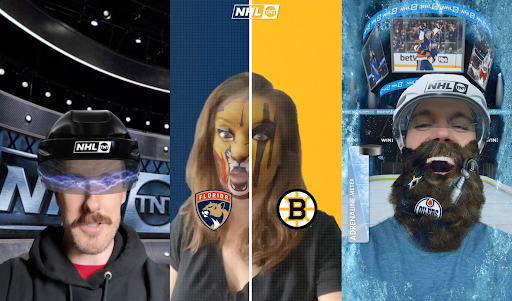Insights from CTV leaders at Dentsu, Horizon Media and more
From Killabears to the Stanley Cup Playoffs, how AR drove deep audience engagement


Matt Maher, founder, M7 Innovations
Augmented reality is not just a passing trend — it is reshaping consumer behavior and engagement across various industries.
As an independent research and development firm, M7 identified early signals that gaming, in-game transactions and engagement with AR were poised for exponential growth. The global gaming market, for example, is projected to reach $256.97 billion by 2025, growing at a compound annual growth rate (CAGR) of 9.17%.
Immersive experiences with augmented reality and gaming enhance user engagement and interaction. AR technology seamlessly integrates digital content with the physical world for highly engaging and memorable moments. AR advertising has been shown to be up to 30 times more effective in capturing user attention than traditional mobile ads.
As a well-known example, the success of games like Pokémon GO highlighted the vast potential of AR to create dynamic, captivating worlds where gamers converge. Pokémon GO blurred the lines between virtual and reality, sparking a universal hunger for experiences that meld the digital with the physical.
Financially, AR has proven to be a game-changer for developers and publishers. The surge in in-game purchases and virtual transactions signifies a robust revenue stream fueled by enriched, interactive experiences — with a projected $74.4 billion market for in-game purchases by 2025. From microtransactions to premium digital goods, players have demonstrated a readiness to invest in enhanced gameplay, indicating a thriving market for innovative AR applications.
How Snapchat and QReal achieved significant audience engagement with AR
Understanding evolving consumer behaviors is crucial for creating experiences that deeply engage audiences.
A notable activation involved partnering with Snapchat and QReal to pilot Snap’s new ‘In Lens Digital Goods’ (ILDG) system. This system enabled in-app purchases within AR experiences, using the Killabears collectible entertainment experience to create an interactive AR environment with purchasable upgrades for ultra-realistic Killabears digital avatars. Building on this success, M7 also developed a Killabears AR video game on Snapchat that achieved over 30 seconds of average dwell time.
The campaign achieved impressive organic results. For example, 96% of Snap users activated the lens, generating 1.26 million lens views and 1.2 million activations. This led to 9,000 shares and 471,300 long plays. Additionally, 88% of users who made an ILDG purchase bought multiple items. The campaign required no paid media spend to achieve these results.
Augmented reality’s big win: Engaging fans at the Stanley Cup Playoffs
Warner Bros. Discovery partnered with M7 Innovations, QReal, Meta and Snapchat to create an innovative AR campaign for the 2024 Stanley Cup Playoffs on TNT. The multi-phase AR experience showcased the power of immersive technologies to drive viewer engagement for marquee live sporting events.
In phase one, a high-energy, adrenaline-fueled AR effect was launched on Instagram and Facebook ahead of the playoffs. This effect teleported fans onto center ice, putting them square in the action as pucks flew and crowds cheered, building excitement for TNT’s playoff coverage.
As the playoffs progressed, a suite of AR lenses allowed fans to virtually choose their team, put on team face paint and share posts showcasing their support. This effect tapped into passionate hockey fandom while promoting TNT’s broadcasts.
The rollout included a “face lens” AR effect for the finals, allowing users to grow their virtual playoff beard in real-time. Interactive features revealed matchup-specific easter eggs. This immersive, shareable experience built anticipation for the championship series.
The AR effects drove measurable business results, including more than 2 million activations with only $15,000 in paid media spend. Over 30,000 fans deep-linked into the Max app to watch the games, generating an average dwell time of approximately 10 seconds across all experiences, five times the industry benchmark. Furthermore, 1 in 10 fans who experienced the lens went directly to Max to watch the respective game, amounting to a $0.02 cost per unique reach and a less than $10 eCPM.
The broader impact and brand benefits of AR
The transformative impact of AR transcends gaming. Retail, e-commerce and healthcare industries leverage this technology to reshape customer interactions and drive operational efficiencies. In retail, AR enables consumers to visualize products in their own space before purchasing, enhancing satisfaction and reducing return rates. In healthcare, AR assists in surgical training, patient education and therapeutic applications, improving outcomes and learning experiences.
As the AR market continues its rapid expansion, projected to grow from $25.3 billion in 2023 to $88.4 billion by 2030 at a CAGR of 23.5%, the opportunities for innovative AR applications across sectors are vast. This growth highlights the wide-reaching implications and boundless potential of AR technologies.
Sponsored by M7 Innovations
More from Digiday

Creator marketing has the reach — CMOs want the rigor
The creator economy got big enough to be taken seriously.

Digiday+ Research: Publishers pull back their dependence on digital revenue
After a year in which publishers shifted their revenue dependence away from traditional channels and toward digital channels, 2025 has seen a shift back toward more of a balance between traditional and digital revenue sources.

Pitch deck: Why Google believes its latest AI Max product is a game changer for search campaigns
AI Max, which launched May and rolls out this summer, aims to provide advertisers with a “one-click feature suite” for search campaigns.








